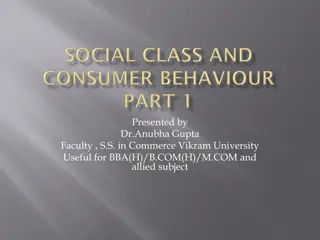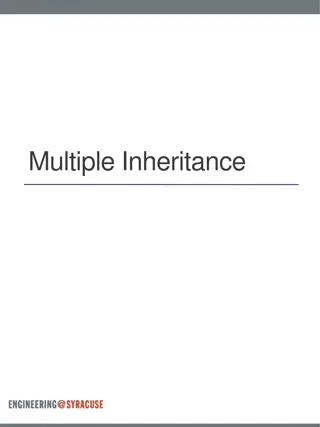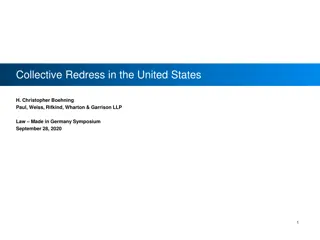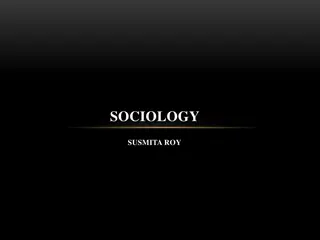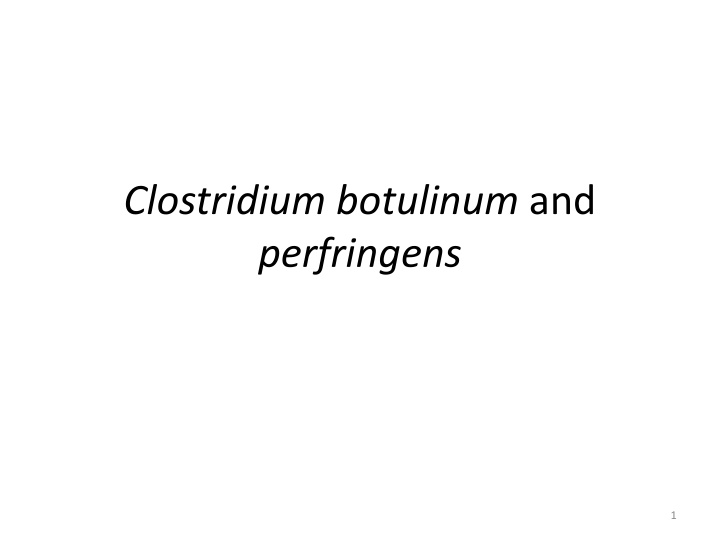
Clostridium Botulinum and Perfringens: Characteristics, Ecology, and Toxin
Learn about the characteristics, ecology, and toxin of Clostridium botulinum and Clostridium perfringens, including their historical background, classification, spore properties, and the disease they cause. Explore how these bacteria thrive in various environments, their neurotoxin effects, and the types of illnesses associated with them.
Download Presentation

Please find below an Image/Link to download the presentation.
The content on the website is provided AS IS for your information and personal use only. It may not be sold, licensed, or shared on other websites without obtaining consent from the author. If you encounter any issues during the download, it is possible that the publisher has removed the file from their server.
You are allowed to download the files provided on this website for personal or commercial use, subject to the condition that they are used lawfully. All files are the property of their respective owners.
The content on the website is provided AS IS for your information and personal use only. It may not be sold, licensed, or shared on other websites without obtaining consent from the author.
E N D
Presentation Transcript
Clostridium botulinum and perfringens 1
Characteristics of Clostridium 2 Gram positive rods in filaments or chains Strict anaerobes (C. bot) to oxygen tolerant (C. perf) Spore forming (endospores) Vegetative cells motile ~55 (C. bot) to 965,000 (C. perf) cases/year in US (#2) Diverse physiologically and biochemically >100 species; only 5 human pathogens C. difficile, C. tetani, C. sordellii Image from Wikipedia
C. botulinum 3 Historically, first recognized foodborne pathogen 1793, outbreak of blunzen in modern day Germany Justinius Kerner, medical officer, identified several cases. Noted more often in larger sausages made with components other than muscle tissue Coined term botulinum (botulus [Lt] = sausage) 1896; determined that this disease caused by toxin
Characteristics of endospores 4 Business end: Low moisture Proteins protecting DNA Endospore stain
Ecology/reservoir 5 Saprophyte Soils (one study suggested 24% of soil samples in US are positive) Aquatic muds (anaerobic, moist, nutrient rich) Spores readily dispersed by dust, aerosols Intestinal tract of animals But not obligatory
Classification of C. botulinum 6 (proteolytic) (non-proteolytic) Properties C. botulinum group I C. botulinum group II C. botulinum group III Neurotoxin A, B, F B, E, F C, D 10oC 3oC 15oC Min. growth temp 35-40oC 18-25oC 35-40oC Opt. growth 48oC 45oC Max. growth NA Min. pH 4.6 5.0 NA Inhibitory aw Inhibitory NaCl 0.94 0.97 NA 10% 5% 3% D100oC spores D121oC spores 25 min <0.1 min NA 0.21 min <0.005 min NA In US, ~60% due to type A, ~20% type B, 20% type E
Characteristics of toxin 7 Most potent toxin known; LD adult human ~0.01 g Enters bloodstream, targets nerve cells Neurotoxin (not enterotoxin) Inhibits acetylcholine release at neuromuscular junctions Only produced during vegetative growth www.hopkins-gi.org
Disease 8 Foodborne botulinum (intoxication) Incubation period 8h to 8d; oft 12-48 h Double/blurred vision, dilated pupils, drooping eyelids Dysphagia, dysphonia Death by respiratory failure Patient remains mentally aware Infant (adult) botulinum (infection) Honey not recommended to children under 1 yrs FDA study suggests 13% are positive Intestinal environment not fully developed Floppy baby syndrome Wound botulinum (infection)
Prevention: mostly a reminder! 9 Prevent growth and toxin production Not possible to prevent contamination Acid and water activity Potentially hazardous foods (pH>4.6, aw>0.85) 12D process Sodium nitrite in cured meats Toxin infrequent in high acid foods unless: Insufficient penetration of acid into food Food contaminated with spoilage organisms that raise pH Inactivate spores D121oCof 0.21 min used as golden rule Inactivate toxin 70 oC/1 h, boiling for 5 min Study suggests standard pasteurization reduces 99.95-99.99% activity
4 features of contaminated food 10 Food contaminated at source or during processing Food receives treatment that restricts competitive microflora (yeasts, LAB) but permits Clostridium survival Conditions of food are suitable for germination and outgrowth Food consumed cold and/or after insufficient heat treatment to inactivate toxin http://extension.psu.edu/food-safety/food-preservation/safe-methods
Notable differences from C. bot 12 Is considered an anaerobe, but is aerotolerant Fast doubling time (<10 minutes) Much more common Less severe disease; self-limiting 14 toxin types (enterotoxins); 4 are typing toxins Type Alpha Beta Epsilon Iota A + - - - B + + + - C + + - - D + - + - E + - - +
C. perfringens disease 13 Infection (not intoxication), high infectious dose (>108) Incubation period ~8-18 hours Some survive gastric transit, get to intestines Vegetative cells sporulate Synthesize toxin Toxin binds to epithelial cells Diarrhea and abdominal cramps Usually resolves spontaneously ~12-24 hours Death rare; elderly or some underlying condition
Characteristics of foodborne illness 14 Beef, poultry (meat, gravies, stews) primarily pH ~5-8.3, temps >15 C Food contaminated with vegetative cells Cells not heat-killed Food temperature abused, not cooled quickly Often when cooking for large groups (group homes, large events)
Policy changing outbreaks 15 Sept 1985: Two sisters and mother develop peripheral weakness and respiratory troubles Type B botulinum toxin in blood Additional cases; link is Vancouver restaurant Garlic was chopped, covered in soybean oil, and stored pH 4.6-5.7 seen in 15 bottles measured





